Overview
The article underscores the critical role of effective wine website design as an essential factor for winery success, particularly in bolstering direct-to-consumer (DTC) strategies. It asserts that well-designed websites—characterized by engaging visuals, intuitive navigation, and compelling storytelling—can profoundly enhance customer engagement, foster brand loyalty, and drive sales. This assertion is supported by successful case studies from various wineries, illustrating the tangible benefits of investing in superior web design.
Introduction
The digital landscape for wineries is evolving rapidly, underscoring the necessity of creating captivating online experiences that resonate with consumers. As family-owned vineyards strive to excel in an increasingly competitive market, the significance of effective website design becomes paramount. This article delves into ten exemplary wine website designs that not only highlight the artistry of winemaking but also employ strategic direct-to-consumer (DTC) approaches.
How can these innovative designs enhance customer engagement and drive sales? What lessons can be gleaned from the best in the industry?
Enocap: Transformative DTC Strategies for Family-Owned Wineries
Enocap is at the forefront of transforming the wine sector, championing direct-to-consumer (DTC) approaches that drive growth for family-owned vineyards. Their comprehensive advisory services are designed to develop robust sales channels, optimize wine club memberships, and implement effective demand generation techniques. Central to these strategies is the establishment of a vineyard's online platform designed with the best wine website design, serving as the primary interface for customer engagement and significantly enhancing brand narratives. A meticulously crafted website with the best wine website design not only attracts potential customers but also cultivates deeper connections, ultimately resulting in increased sales and customer loyalty.
By leveraging established methods that have propelled vineyards to achieve up to 191% e-commerce growth, Enocap empowers these businesses to create captivating online interactions that resonate with consumers. This focus on engaging digital experiences ensures sustainable growth and long-term success in an increasingly competitive market. Notably, 76% of consumers are more inclined to consider brands that personalize their online interactions, underscoring the critical need for wineries to adapt their digital strategies to align with evolving consumer preferences. This adaptability is essential for .
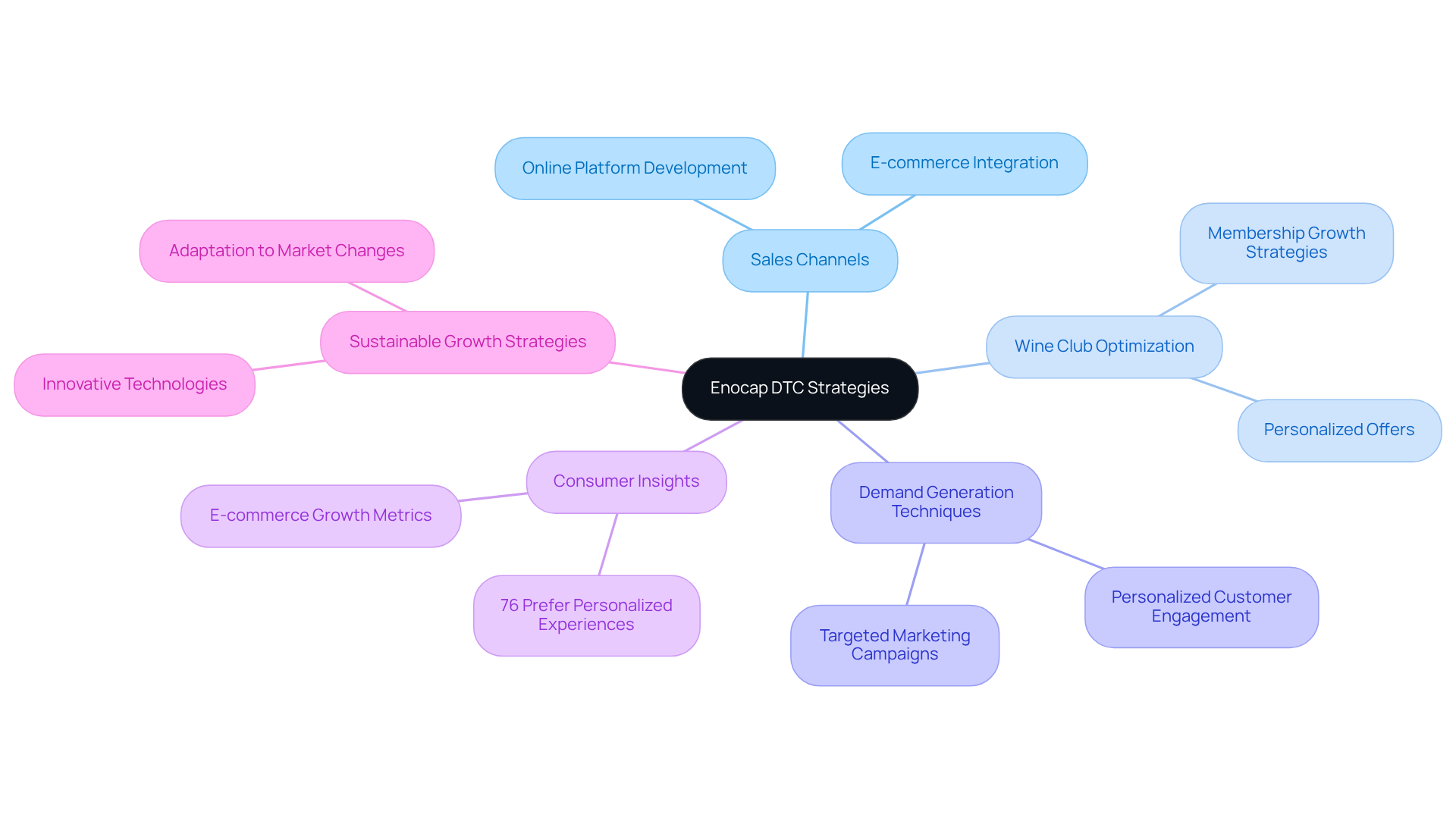
Epoch Estate Wines: A Model of Elegance and User Experience
Epoch Estate Wines exemplifies the best wine website design, showcasing its dedication to quality and craftsmanship while aligning with proven direct-to-consumer strategies. By incorporating high-resolution images of its vineyards and wines, the site provides an engaging atmosphere that captivates visitors and transforms casual buyers into loyal club members. The elegant layout and intuitive navigation of the best wine website design significantly enhance user experience, allowing potential customers to effortlessly explore offerings and engage with the brand. This approach not only reflects the establishment's identity but also aligns with best practices in web design, specifically the best wine website design, where can boost conversion rates by up to 400%. Furthermore, a well-designed user interface (UI) can increase conversion rates by up to 200%, emphasizing the profound impact of design on user engagement and customer retention.
Other successful instances, such as Oliver Winery and Domaine Carneros, underscore the significance of high-resolution imagery and seamless e-commerce functionality in creating effective online platforms for wineries. As such, Epoch Estate Wines serves as a compelling model for other wineries aspiring to elevate their online presence with the best wine website design, implement transformative DTC strategies, and connect more deeply with consumers.
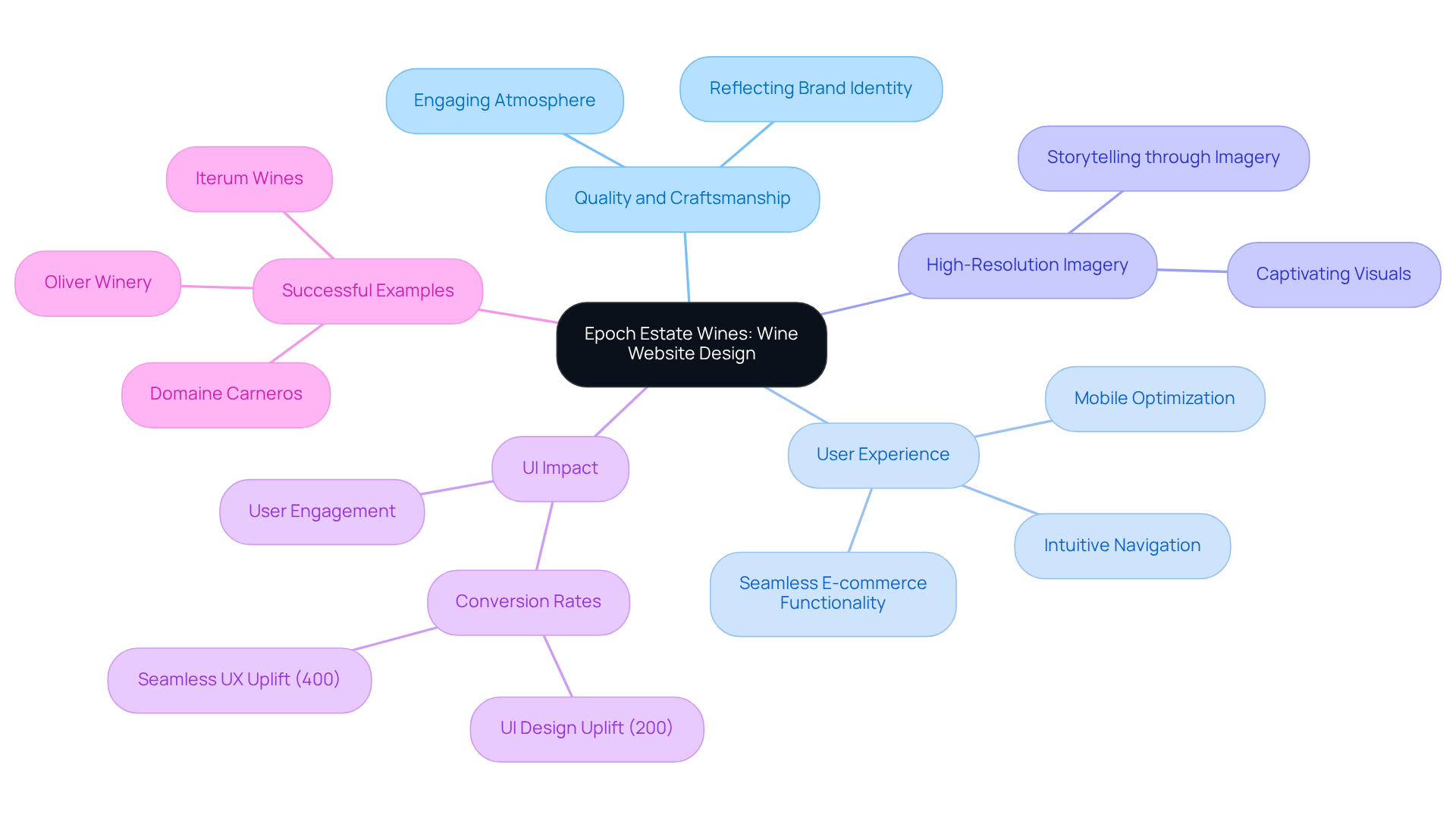
Moët & Chandon: Luxury Branding Through Exceptional Website Design
Moët & Chandon's website exemplifies luxury branding, distinguished by its sophisticated design and intuitive user interface. The sleek layout, enriched by captivating visuals and engaging content, not only mirrors the brand's illustrious heritage but also emphasizes its steadfast commitment to quality.
By integrating storytelling elements throughout the site, Moët & Chandon enthralls visitors, crafting an immersive experience that cultivates a deeper connection with the brand. This strategic amalgamation of narrative and interactivity is vital for establishments aiming to establish a foothold in the luxury market, as it significantly bolsters brand loyalty and consumer engagement.
Effective storytelling is a tested strategy for converting casual buyers into devoted club members, a necessity for family-owned businesses striving to develop sustainable direct-to-consumer channels. Research indicates that 80% of consumers are more likely to purchase from a brand that provides personalized interactions, highlighting the importance of this approach.
As Frank DePino, Principal and Founder of Mediaboom, asserts, 'Creating the best wine website design is essential for enhancing your establishment's digital presence.' This strategy not only resonates with consumers seeking engagement that aligns with their values and aspirations but also addresses the challenges of ensuring , both of which are essential for luxury branding.
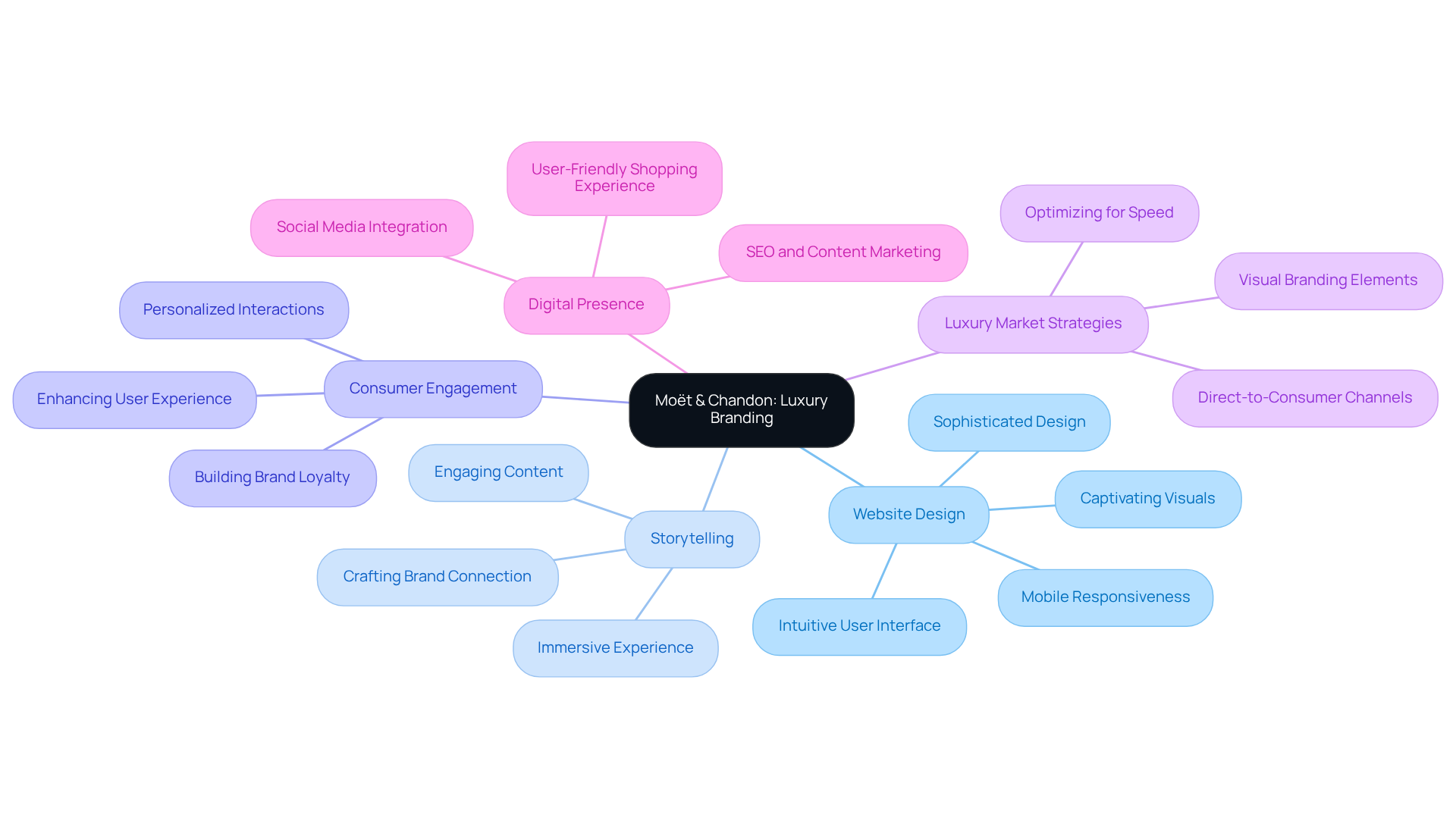
Jordan Winery: Engaging Storytelling and Visual Appeal
Jordan Winery exemplifies the power of engaging storytelling combined with visual appeal. Its online platform showcases a well-curated blog and rich multimedia content that narrates the winery's history, winemaking techniques, and culinary pairings. By intertwining captivating visuals with intriguing narratives, Jordan Winery creates an immersive online environment that resonates deeply with visitors. This strategic approach not only attracts potential customers but also cultivates a , encouraging repeat visits and fostering customer loyalty. The incorporation of multimedia components significantly boosts user involvement, making the platform one of the best wine website designs for establishing a robust digital presence.
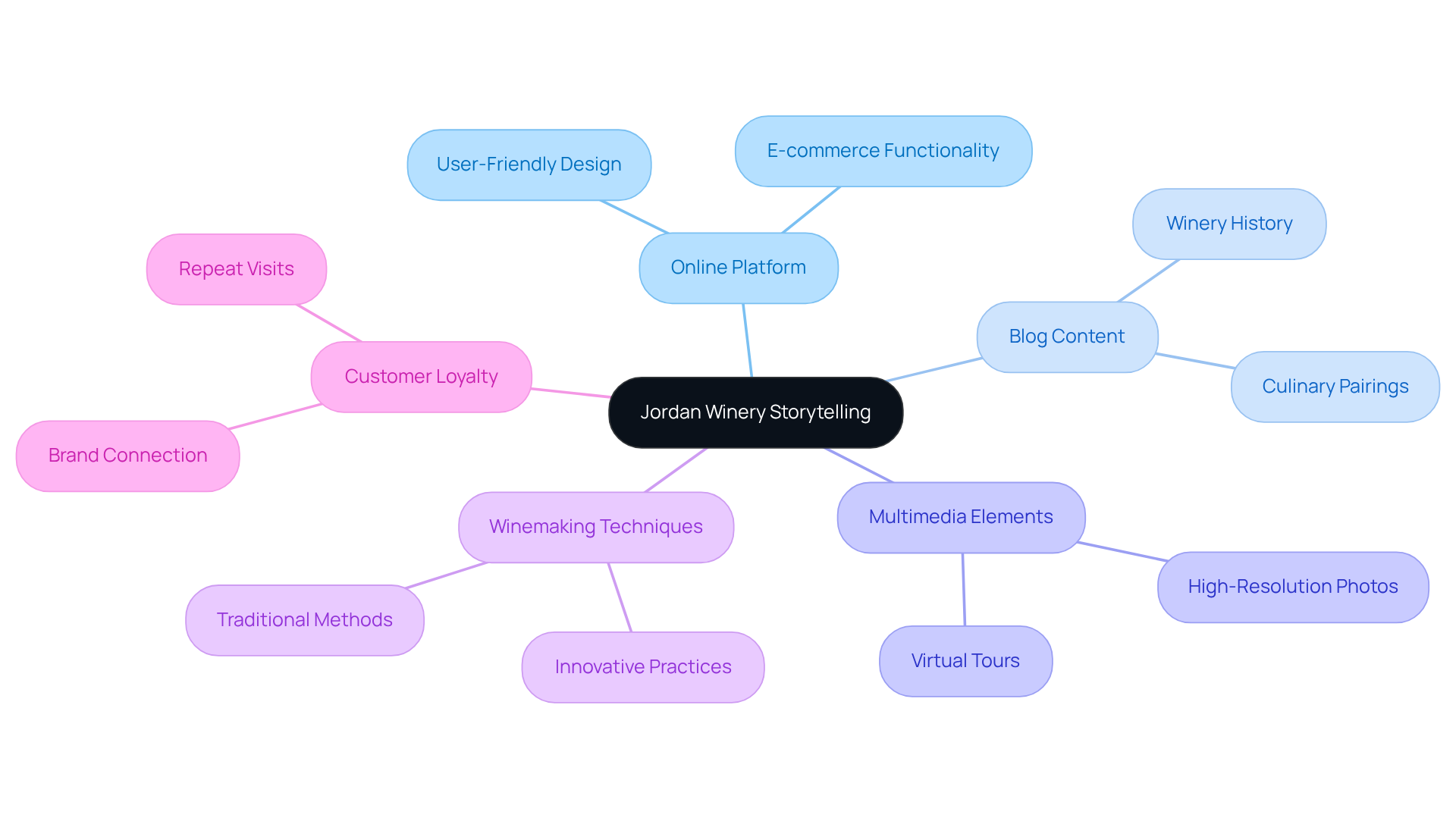
Oliver Winery: Seamless Navigation and E-Commerce Integration
Oliver Winery exemplifies the significance of user-centric design, showcasing seamless navigation and robust e-commerce integration. Visitors can effortlessly browse wine selections, read detailed tasting notes, and with minimal friction. The platform employs high-quality visuals and clear calls-to-action, significantly enhancing the shopping journey and fostering customer involvement. This approach not only simplifies the purchasing process but also cultivates a stronger connection with the brand, serving as a prime example of the best wine website design for wine producers aiming to elevate their online sales channels.
Notably, studies indicate that 50% of consumers form their initial perception of a business based on its online design, underscoring the necessity for wineries to prioritize the best wine website design that features intuitive navigation and user interaction in their digital strategies.
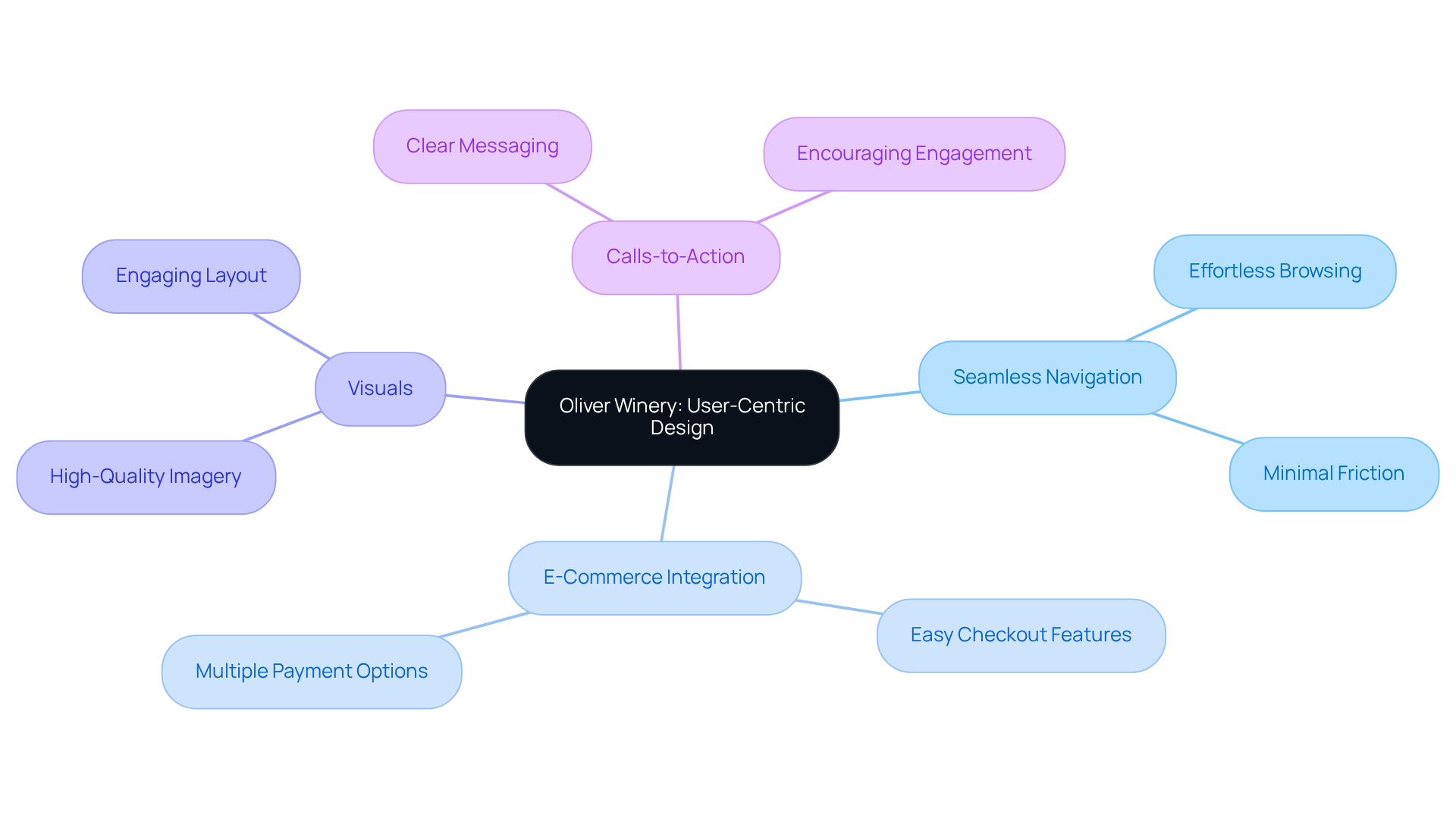
Long Meadow Ranch: Blending Rustic Charm with Modern Design
Long Meadow Ranch's website exemplifies the perfect fusion of rustic charm and contemporary design, underscoring its commitment to [sustainable agriculture and exceptional winemaking](https://seahawkmedia.com/wordpress/wine-website-design-ideas). The use of warm color palettes and inviting imagery fosters a user-friendly experience that resonates deeply with visitors. By integrating storytelling elements that highlight the ranch's heritage and sustainable practices, Long Meadow Ranch not only captivates its audience but also fortifies its brand identity. This strategic approach serves as a compelling model for wineries aiming to cultivate a through the best wine website design.
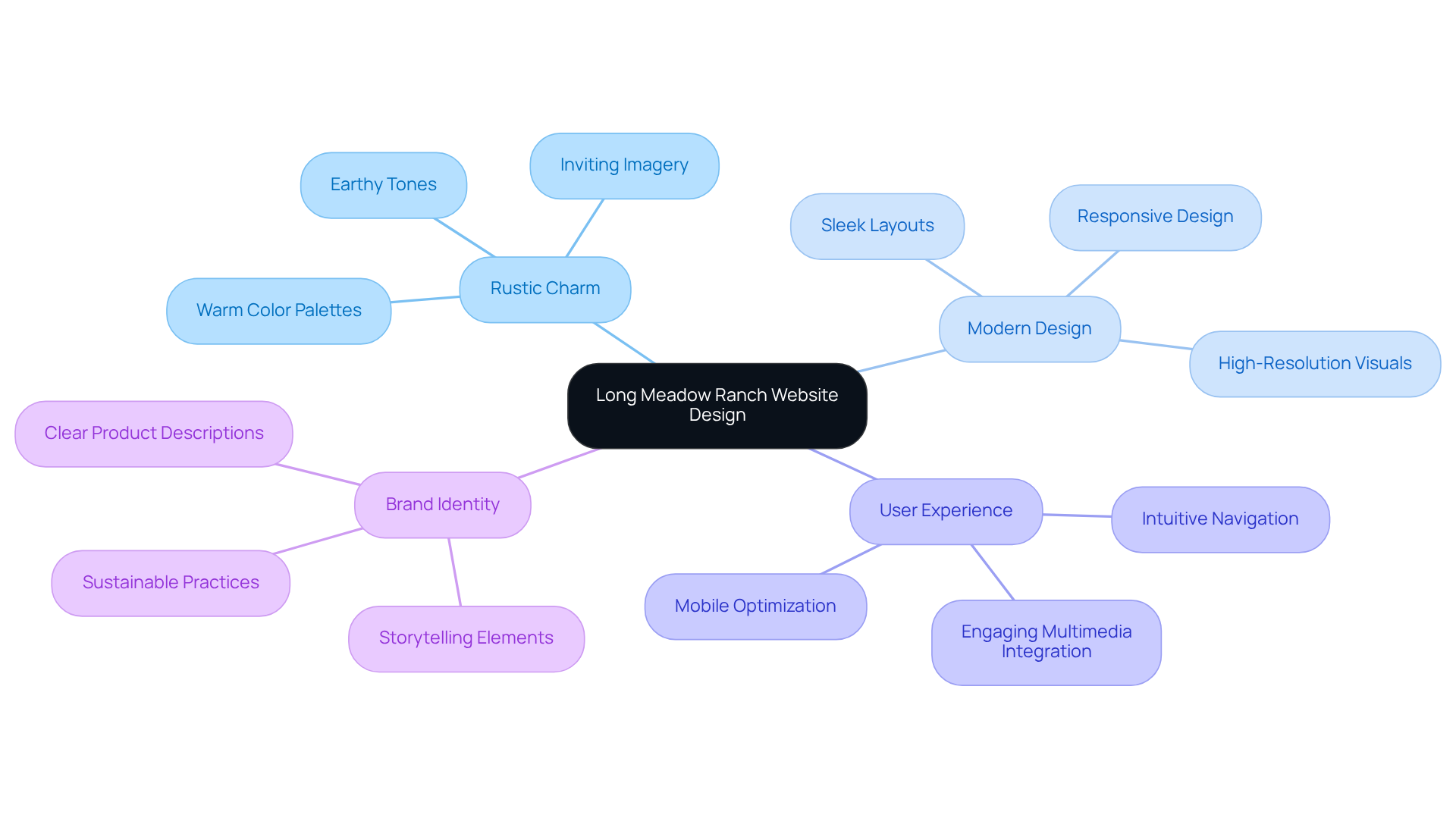
Domaine Carneros: Stunning Visuals and Immersive Experience
Domaine Carneros' website, known for its breathtaking visuals, elegantly showcasing its picturesque estate and exquisite wines, exemplifies the best wine website design. By utilizing high-resolution images, captivating videos, and interactive features, the site exemplifies the best wine website design, creating an immersive environment that resonates deeply with users. By showcasing the beauty of its vineyards and the meticulous craftsmanship behind its wines, Domaine Carneros effectively attracts potential customers while enhancing brand perception through the best wine website design.
This approach is vital for vineyards aiming to establish a memorable online presence through the best wine website design; research indicates that 87% of consumers believe social media influences their purchasing decisions. Immersive website experiences, exemplified by the best wine website design, not only engage visitors but also foster emotional connections, significantly increasing the likelihood of converting them into loyal customers.
To further bolster their online visibility, vineyards should adopt established and implement the best wine website design. This includes:
- Crafting engaging brand stories
- Optimizing wine club memberships
- Implementing demand generation techniques to drive consistent growth and customer retention through the best wine website design
Furthermore, regularly gathering customer insights can empower vineyards to refine their branding and marketing strategies, thereby strengthening their connection with the audience through the best wine website design.
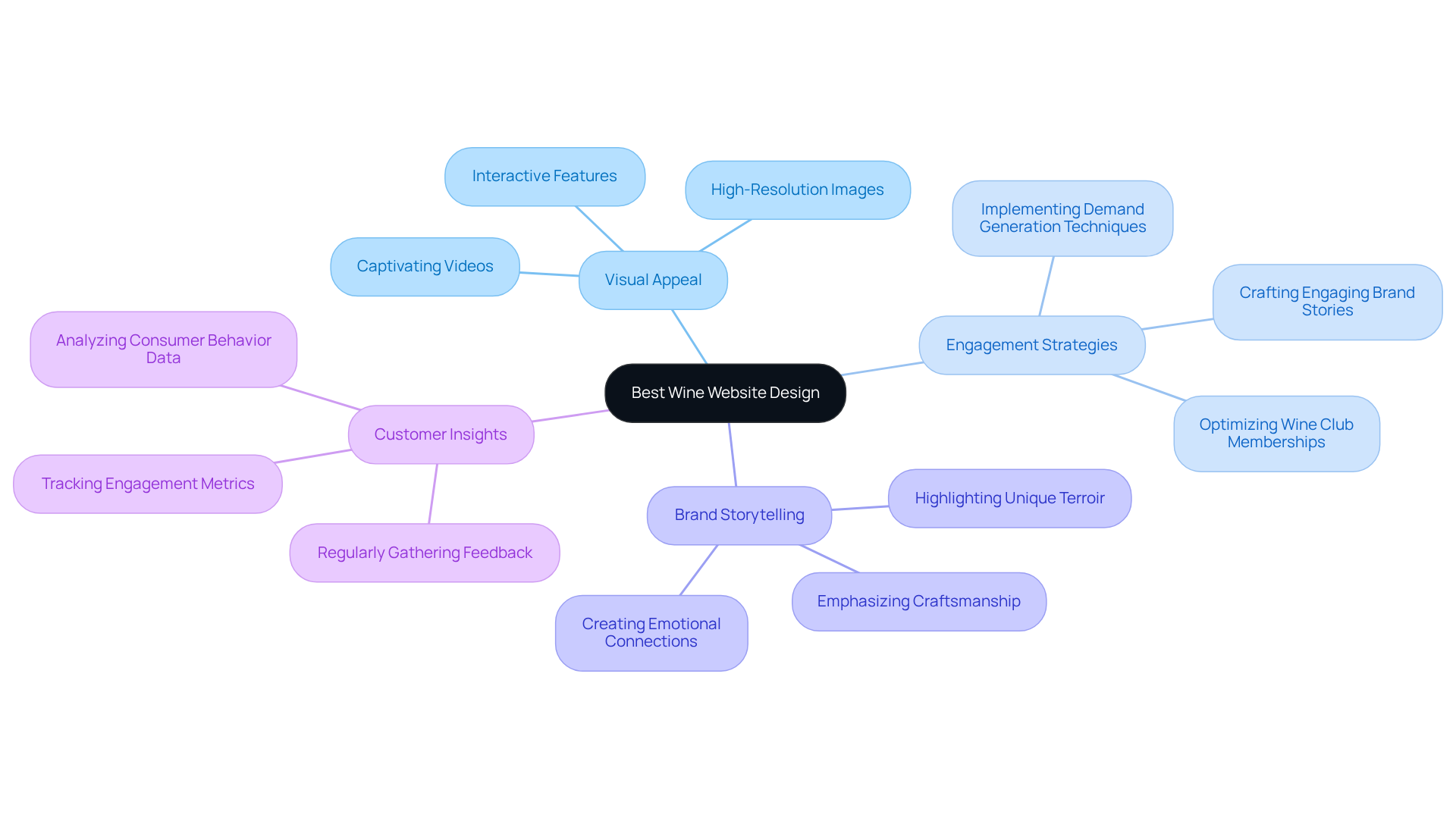
Kerry Hill Winery: Innovative Use of Multimedia for Engagement
Kerry Hill Winery exemplifies effective use of multimedia elements on its website, engaging visitors and enhancing storytelling. The site features:
- Videos
- Interactive maps
- High-quality images
These elements showcase the establishment's offerings and experiences. By integrating diverse content formats, Kerry Hill Winery cultivates a dynamic online environment that captivates visitors and invites exploration. This innovative approach not only captivates but also serves as a valuable lesson for vineyards seeking the to enhance their digital presence. As the wine industry continues to evolve, embracing such strategies is essential for standing out in a competitive landscape.
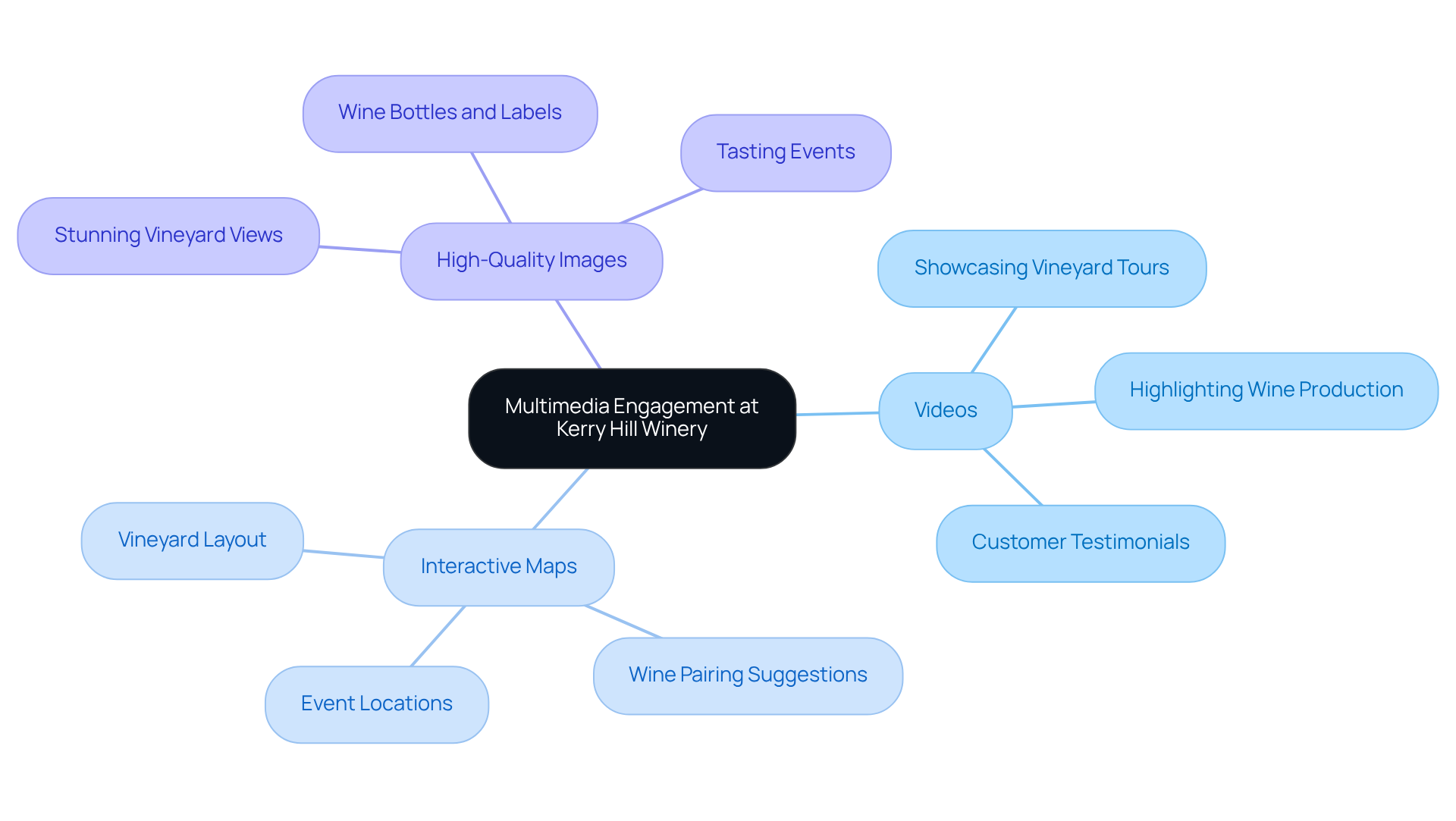
Wente Vineyards: SEO and Mobile Optimization Excellence
Wente Vineyards stands out with its exceptional SEO and , which contribute to the best wine website design, ensuring that its online presence is both easily discoverable and user-friendly across various devices. The vineyard employs responsive designs, ensuring the best wine website design can adjust seamlessly to different screen sizes—an essential feature, considering that over 80% of high-performing websites prioritize mobile-friendliness.
Fast loading times are a key focus of the best wine website design, supported by research indicating that 53% of mobile users abandon a site if it takes longer than three seconds to load. This dedication to speed not only enhances user experience but also significantly improves the search visibility of the best wine website design.
By honing in on these technical aspects, Wente Vineyards effectively attracts more visitors and fosters increased user interaction, which is a crucial strategy for establishments aiming to implement the best wine website design to elevate their online visibility and drive sales.
To further cultivate customer loyalty, wineries should contemplate weaving storytelling into their brand narrative, highlighting their unique heritage and values. Additionally, adopting direct-to-consumer strategies, such as personalized email marketing and exclusive membership benefits, can convert casual buyers into dedicated club members.
Utilizing tools like Google PageSpeed Insights can ensure that the platform operates optimally across devices, thereby enhancing its overall effectiveness.
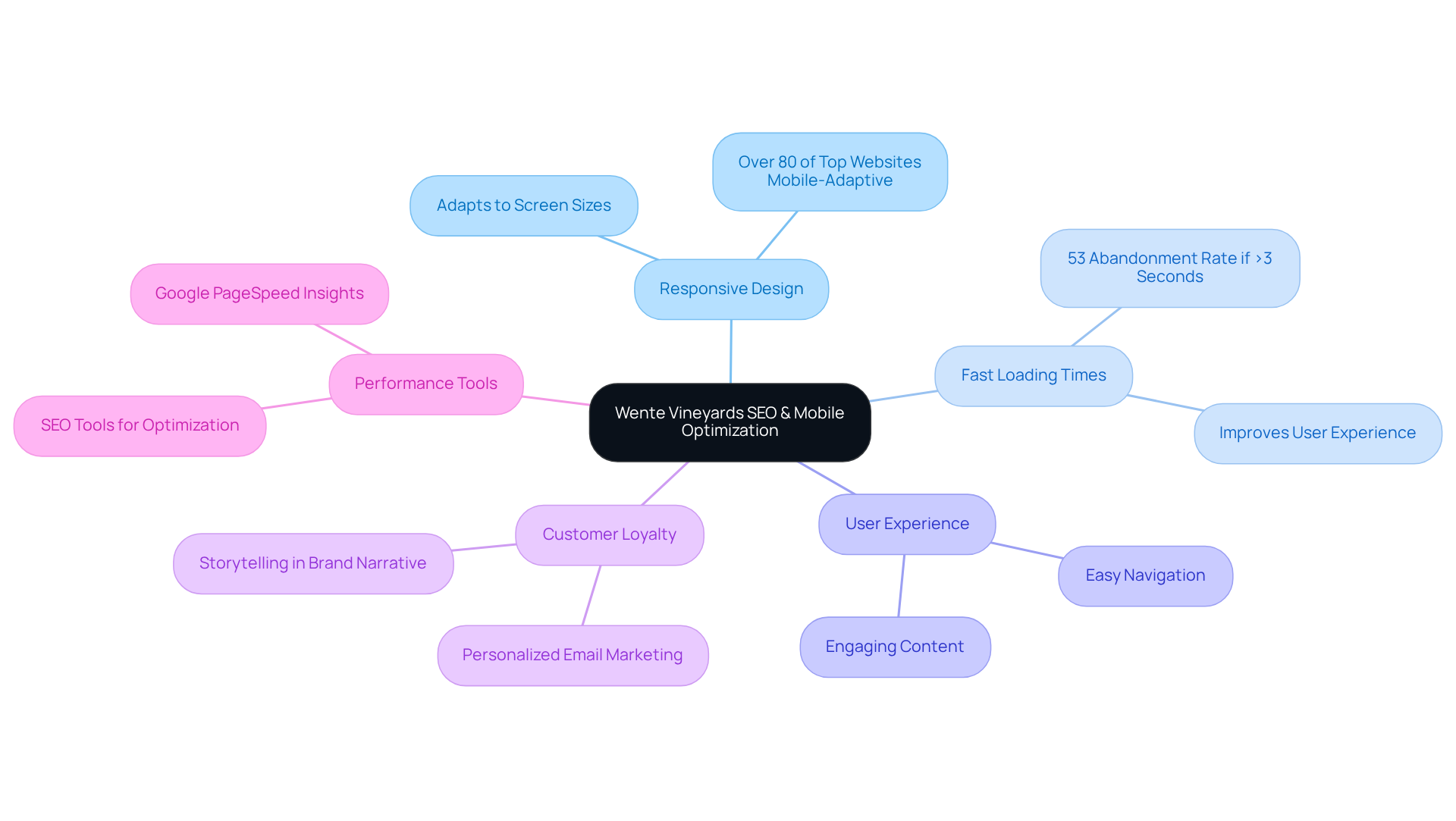
Chateau Ste. Michelle: A Comprehensive Approach to Design and Functionality
Chateau Ste. Michelle's website represents the best wine website design, showcasing a paragon of design and functionality with an elegant layout and intuitive navigation. The engaging content not only mirrors the establishment's rich heritage but also showcases its diverse offerings. By seamlessly integrating e-commerce capabilities with compelling storytelling elements, Chateau Ste. Michelle cultivates an immersive experience that invites visitors to explore and make purchases. This balanced approach serves as an exemplary model for wineries aiming to achieve the to enhance their online presence and drive sales through effective digital strategies.
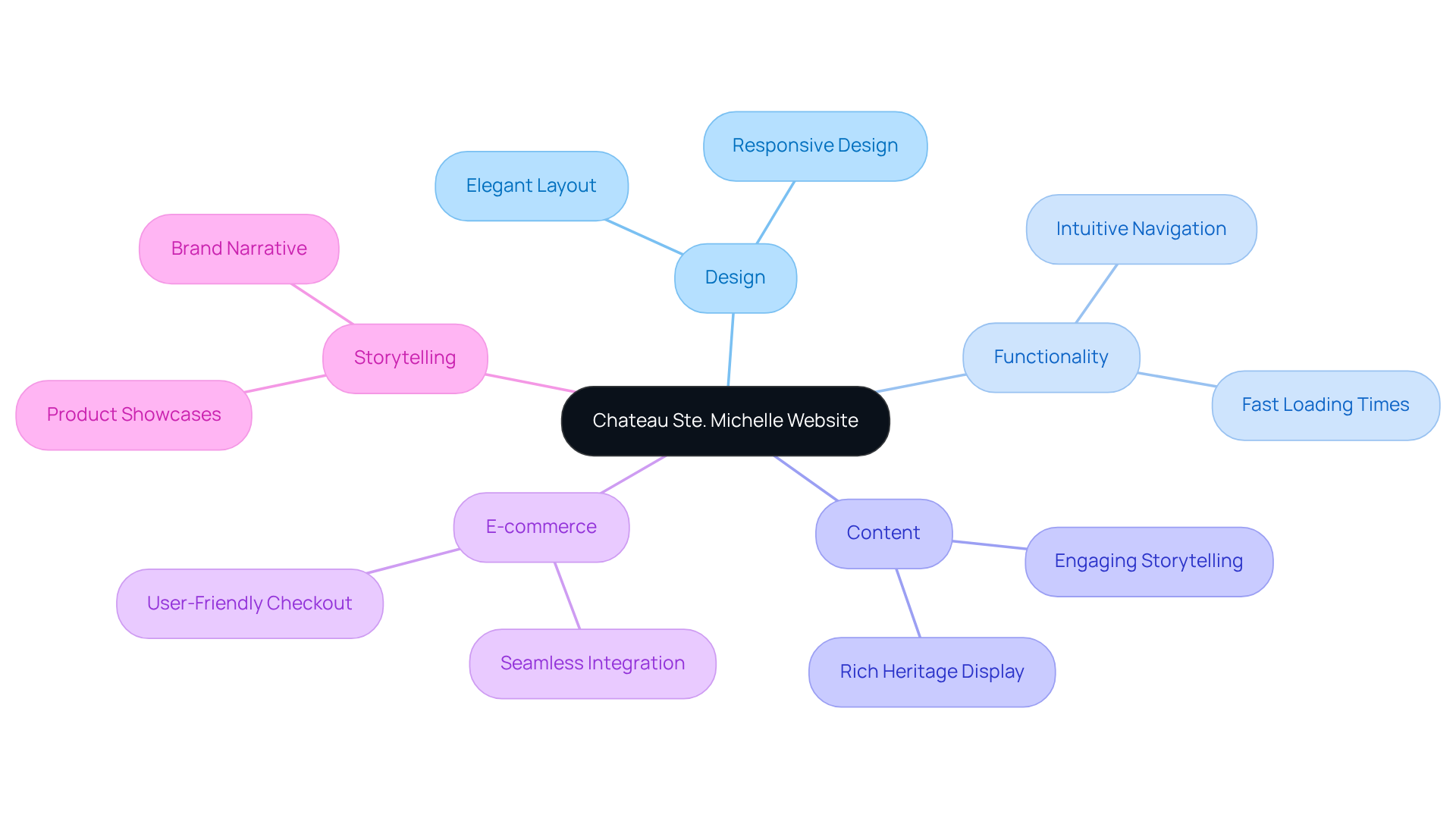
Conclusion
Establishing an exceptional online presence is imperative for wineries striving to excel in a competitive environment. The most effective wine website designs not only embody the brand's identity but also elevate customer engagement through intuitive navigation, captivating visuals, and compelling storytelling. By embracing direct-to-consumer strategies, wineries can forge meaningful connections with their audience, ultimately boosting sales and cultivating loyalty.
Throughout this article, various wineries illustrate how impactful website design can revolutionize customer interactions.
- Enocap highlights DTC strategies that empower family-owned vineyards.
- Epoch Estate Wines and Moët & Chandon underscore the significance of high-quality visuals and storytelling in luxury branding.
- Other examples, such as Oliver Winery and Jordan Winery, emphasize seamless navigation and engaging content as essential elements of a successful online platform.
Each case reinforces the idea that a well-crafted website serves as a formidable tool for enhancing brand perception and customer experience.
As the wine industry evolves, adopting innovative design elements and customer-centric strategies becomes increasingly vital. Wineries are urged to prioritize optimal wine website design to not only attract visitors but also convert them into loyal customers. By concentrating on personalization, multimedia engagement, and mobile optimization, wineries can amplify their digital footprint and secure long-term success in the market.
Frequently Asked Questions
What is Enocap and what role does it play in the wine sector?
Enocap is an organization focused on transforming the wine sector by promoting direct-to-consumer (DTC) strategies that drive growth for family-owned vineyards through advisory services.
What services does Enocap provide to wineries?
Enocap offers comprehensive advisory services designed to develop robust sales channels, optimize wine club memberships, and implement effective demand generation techniques.
How important is a vineyard's online platform according to Enocap?
A vineyard's online platform is crucial as it serves as the primary interface for customer engagement, enhances brand narratives, and significantly contributes to attracting potential customers and cultivating deeper connections.
What impact can a well-designed website have on wine sales?
A meticulously crafted website can lead to increased sales and customer loyalty by creating captivating online interactions that resonate with consumers.
What e-commerce growth have vineyards achieved with Enocap's methods?
Vineyards have achieved e-commerce growth of up to 191% by leveraging established methods promoted by Enocap.
Why is personalization important for wineries?
Personalization is critical as 76% of consumers are more inclined to consider brands that personalize their online interactions, highlighting the need for wineries to adapt their digital strategies.
What does Epoch Estate Wines exemplify in the wine industry?
Epoch Estate Wines exemplifies the best wine website design, showcasing quality and craftsmanship while aligning with effective direct-to-consumer strategies.
How does the website design of Epoch Estate Wines enhance user experience?
The elegant layout and intuitive navigation of the website allow potential customers to effortlessly explore offerings and engage with the brand, significantly enhancing user experience.
What impact can high-quality visuals have on conversion rates for wineries?
High-quality visuals can boost conversion rates by up to 400%, while a well-designed user interface can increase conversion rates by up to 200%.
What lessons can other wineries learn from Epoch Estate Wines?
Other wineries can learn the importance of high-resolution imagery, seamless e-commerce functionality, and effective online platforms to elevate their online presence.
How does Moët & Chandon's website reflect luxury branding?
Moët & Chandon's website features a sophisticated design, captivating visuals, and engaging content that mirror the brand's heritage and commitment to quality.
What storytelling elements are integrated into Moët & Chandon's website?
The website integrates storytelling elements to create an immersive experience that cultivates a deeper connection with the brand, essential for luxury market positioning.
Why is effective storytelling important for family-owned wineries?
Effective storytelling helps convert casual buyers into devoted club members, which is necessary for family-owned businesses to develop sustainable direct-to-consumer channels.
What challenges must luxury brands address in their website design?
Luxury brands must ensure mobile responsiveness and optimize for speed to enhance their digital presence and meet consumer expectations.




